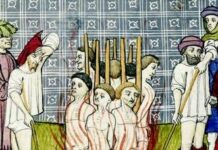
Ebook Info
- Published: 2004
- Number of pages: 560 pages
- Format: PDF
- File Size: 5.19 MB
- Authors: Malcolm Barber
Description
First published to wide critical acclaim in 1992, The Two Cities has become an essential text for students of medieval history. For the second edition, the author has thoroughly revised each chapter, bringing the material up to date and taking the historiography of the past decade into account.The Two Cities covers a colourful period from the schism between the eastern and western churches to the death of Dante. It encompasses key topics such as:the Crusadesthe expansionist force of the Normansmajor developments in the way kings, emperors and Popes exercised their powersa great flourishing of art and architecturethe foundation of the very first universities. Running through it all is the defining characteristic of the high Middle Ages: the delicate relationship between the spiritual and secular worlds, the two ‘cities’ of the title. This survey provides all the facts and background information that students need, and is defined into straightforward thematic chapters. It makes extensive use of primary sources, and makes new trends in research accessible to students. Its fresh approach gives students the most rounded, lively and integrated view of the high Middle Ages available.
User’s Reviews
Editorial Reviews: Review ‘Meets every conceivable need and effectively renders redundant all earlier textbooks on the high Middle Ages … in short, the book is excellent in every respect.’ – History Today About the Author Malcolm Barber is Professor of Medieval History at the University of Reading. His many books include The Templars, The Cathars and The New Knighthood, A History of the Order of the Temple.
Reviews from Amazon users which were colected at the time this book was published on the website:
⭐Very detailed and comprehensive study of an era of great change.
⭐Thanks!
⭐If you want a detailed overview of the classic medieval period from the 11th – 14th centuries, this is the book for you. It provides an excellent narrative analysis of Europe’s primary players during this period, and the impact/relationship of the church, both in secular and spiritual matters. As the title implies, the book reviews and demonstrates that the secular monarchies of the time and the church were heavily intertwined and needed each other — or at least were interdependent.The book is a well organized historical narrative that looks at medieval society as a whole, first by examining the social and economic structures, the church, and the politics of the period. Given the importance of the Holy Roman empire at the beginning of the period, and the political links between it and the church, there is a focus on that relationship.However, that does not mean other monarchies are ignored, although not as fully explored. Additional chapters examine England, France, Iberia, eastern and northern Europe, Sicily, and the Crusader Kingdoms. Berber links them all together in what only can be described as a historical tapestry. One thing to keep in mind is that this is a “traditional” approach to history in that it examines the leaders and politics of the time, vice the everyday person.The only downside to the book, and it’s a natural by-product of such a complicated study, is that it becomes difficult at times to track all the players, and their relationships to each other — it causes the book to bog down at times. Having said that, it’s definitely worth reading to get the big picture.
⭐In my book, “Astronomical Symbols on Ancient and Medieval Coins”, I devote a number of chapters to the astronomical symbols that were depicted on medieval coinage as signs of divine right to sovereignty. As part of my research, I read numerous books on medieval history, and I found that Barber’s book, “The Two Cities,” was of some value.Although there were many items of interest that added to my understanding of the history of this period, I found that I was often asking more detailed questions than Barber’s book could answer. However, Barber does provide a good overall starting point and provides a lot of information in a single volume.I recommend this book to all who are interested in reading an introductory book on medieval history. I bought the 1994 paperback version, and do not recommend spending the high price for a hardcopy. This book is just a starting point for those readers who are serious about medieval history.Marshall Faintich
⭐This is a very readable book, suitable as an introduction for any reader interested in learning about Medieval Europe in the period from 1050-1320. This is a time of much change in Europe, with the Crusades, religious reform movements, the beginning of the creation of nation states, the struggle between Papacy and Hohenstaufen, and a growing perception of culture which grew in time into what is generally called the Renaissance.Malcom Barber’s writing is very approachable; his obvious enjoyment of his subject comes across in the book, and as such it is very readable to anyone who is interested, whether you approach the period with prior knowledge or not. The writing style allows for a comprehensive understanding of what can be very complex subjects in a broad geographic and chronological timeframe.The book is broken into four main sections: social and economic structure, the Church, political change, and perceptions of the world, and approaches the period thematically overall. A brief but good bibliography follows to lead the reader to more books on subjects of interest. The title of the book, The Two Cities, refers to one of the main themes that holds throughout the book, the comparison and contrast between the secular and the ecclesiastical; and how their interaction shaped and formed this period in European history.A very worthwhile read for anyone interested in the period. A particularly good book for anyone who approaches the subject with little or no knowledge; this book offers a very good introduction to such a reader, and a continuing reference book that will be used and referred to again and again.
⭐very good book for a very good price
⭐This was a reccomended textbook at uni for first getting to grips with the era. I didn’t bother reading it as uni was too specialised to care about generic overviews but read after uni and does what it says on tin. Interesting read but useless for uni
⭐The rendering of images, tables and other important references in the Kindle version of this book are absolutely appalling. Many cannot be viewed at all, therefore no stars here. But I have to put one: “star rating required”!
⭐I bought this for my university course and it has helped. It is an interesting read! I would recommend this!
Keywords
Free Download The Two Cities: Medieval Europe 1050–1320 2nd Edition in PDF format
The Two Cities: Medieval Europe 1050–1320 2nd Edition PDF Free Download
Download The Two Cities: Medieval Europe 1050–1320 2nd Edition 2004 PDF Free
The Two Cities: Medieval Europe 1050–1320 2nd Edition 2004 PDF Free Download
Download The Two Cities: Medieval Europe 1050–1320 2nd Edition PDF
Free Download Ebook The Two Cities: Medieval Europe 1050–1320 2nd Edition

